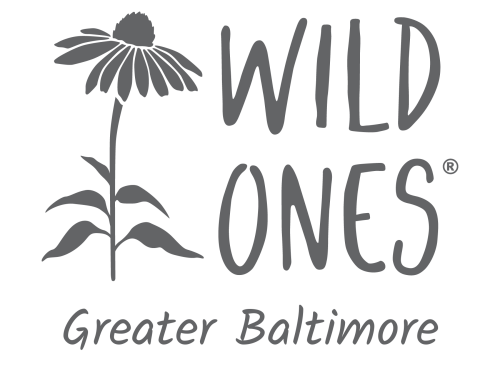by Vinaya Frank ✎
WHEN WE FIRST ARRIVED at Cristina’s Poplar Hill property nestled behind a tall metal gate, we got a sneak peek of the beauty inside–a tantalizing tip off to a hidden gem like I have never seen. Cristina was the perfect host, who provided so many wonderful anecdotes about the plants she chose to include on her property, and I’ll narrate our visit to her garden in the hope of bringing her garden to life for you as she did for us.
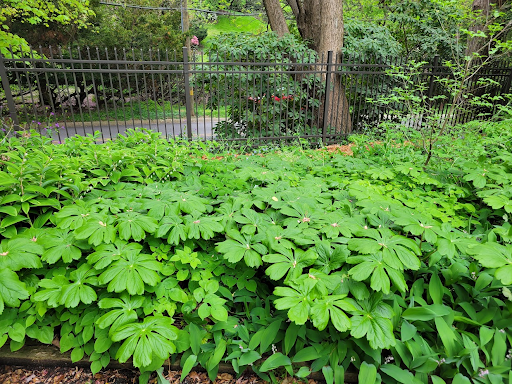
ABOVE is the largest and the tallest Patch of Mayapples (Podophyllum Peltatum) I have ever seen. The mayapples were 2-3ft tall and the blooms typically hidden under the leaves were clearly visible without us needing to bend over.
Cristina has been native gardening on her property for more than 25 years. She bought the property in the ‘90s and, as with most properties, it was riddled with non-native invasive plants and featured an excess of turf grass. She started by restoring one small area at a time, gathering and planting native plants in each section of her yard.
“I am a collector!” Cristina says. Over the years she has continually bought plants that were different from what were commonly available in trade, and back then native plants were (and in fact still are) not readily available in box store nurseries. Fast forward to present–her yard is a native gardener’s dream that is filled with mature native plants living in perfect harmony with each other and is a habitat garden for a wide array of species that depend on those plants. Let’s take a literary tour through her yard, shall we?

THE POND—Her garden features a pond on the sunniest part of the yard. It has a cascading water feature that she had professionally installed. Cristina designed the pond using flagstones to keep the look organic and natural looking. Around the pond, there are several native plant species: Golden Ragwort (Packera aurea), Wild Lupine (Lupinus perennis), Bird’s foot violets (Viola pedata). In the pond itself we saw several lily pad species, pickerel weed (Pontederia cordata), and blue flag iris (Iris versicolor).
Note the density of plants—all acting as green mulch to keep invasives from taking up residence.
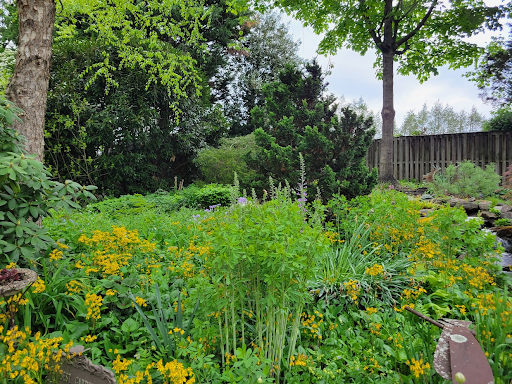
GARDEN LAYERS—Cristina has wonderfully incorporated different heights of plants creating a multi-layered garden design. Both evergreen and deciduous trees (tallest layer) is located in the back, and a closer in are a few multi-stemmed understory trees and shrubs (second tallest layer), while the densely planted forbs form a green groundcover in the foreground. This type of layering in the garden is not only pleasing to look at, with their varying heights, but also appears very neat and intentional, busting the widely held myth that native gardens appear wild and unkempt.
WOOD CHIPPED PATHWAYS—Cristina has managed to completely eliminate all turf on her property. Every area is heavily planted. All flowerbeds are connected by several channels of woodchip pathways so anyone can easily get to the busiest and the furthest corner of her yard.
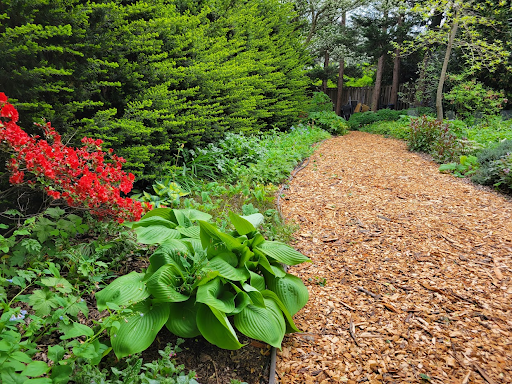
Lining this path on the left side of the picture above is a row of Virginia bluebells (Mertensia virginica) along with wild columbine (Aquilegia canadensis), solomon’s seal (Polygonatum biflorum) and a few non-native hostas. You also see fern fiddleheads breaking ground further up along the path. Ferns and other late emerging plants will fill in the space once the bluebells die back in summer. Along the right side of the path, there is a healthy section of shade loving plants, such as Solomon’s seal and non-native bleeding hearts that are combined with sun loving plants such as Foxglove beardtongue (Penstemon digitalis ‘Husker Red’). Much to my surprise, plants that typically prefer shade (e.g., Solomon’s seal) and those that prefer sun (e.g., Foxglove beardtongue) were seen coexisting wonderfully in this ‘part shade’ area of the yard.
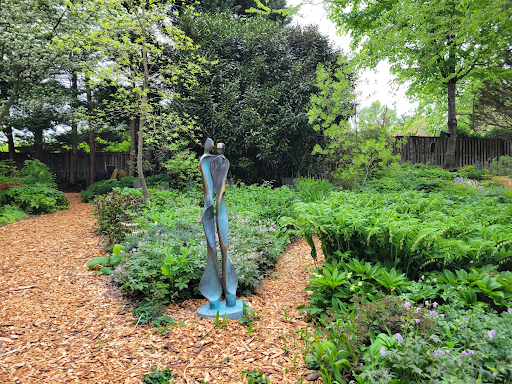
Cristina has added several artificial as well as living accent pieces to her yard. Here a statue draws your eyes in as you walk in her backyard, and behind it a sourwood tree (Oxydendrum arboreum) acts as a living specimen. Notice the large patch of solomon’s seal (Polygonatum biflorum) and wild geranium (Geranium maculatum) as ground covers serving to enhance the specimens.
Ferns are the solution a dry shady spot under pines: Another “wow” moment was when we reached this dry shady spot occupied by maidenhair fern (Adiantum pedatum). Cristina tried a few different plants in this spot and, while many simply existed, the native maidenhair fern thrived and preferred the area under a white pine tree (Pinus strobus) over any other area in her yard.

GROUNDCOVER BETWEEN FLAGSTONES—This was my #1 favorite area of her yard—a carpet of pussytoes (Antennaria Plantaginifolia) planted between widely spaced flagstones used as stepping stones. The beautiful rosettes of pussytoes were low to the ground making a wonderful ground cover around the stepping stones in a walking path. Pussytoes can tolerate a little foot-traffic and won’t be harmed if they get accidentally stepped on. Also, notice a few violets (Viola sororia) sprinkled in between the flagstones. Native violets are another good option for ground cover around the stepping stones.
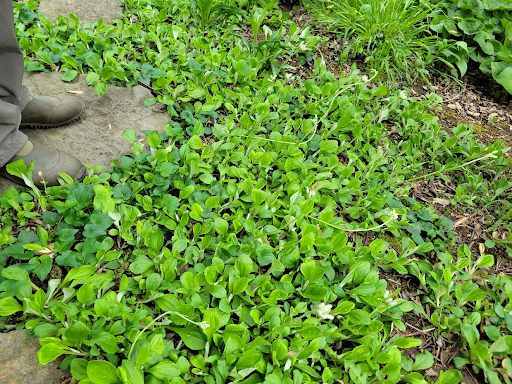
Shade loving Bloodroot (Sanguinaria canadensis), Virginia bluebells (Mertensia virginica), Wild ginger (Asarum canadense) were giving each other company in a dense planting of spring ephemerals in a shadier spot.
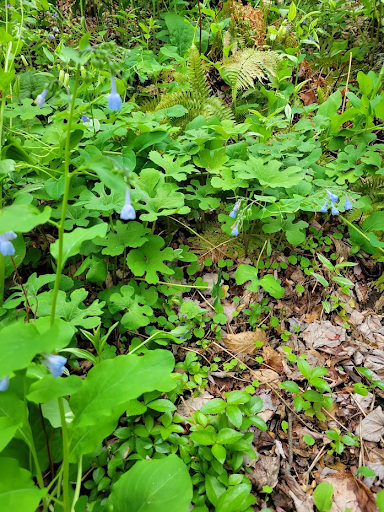
Also, a tall and dense patch of Bellwort (Uvularia perfoliata).
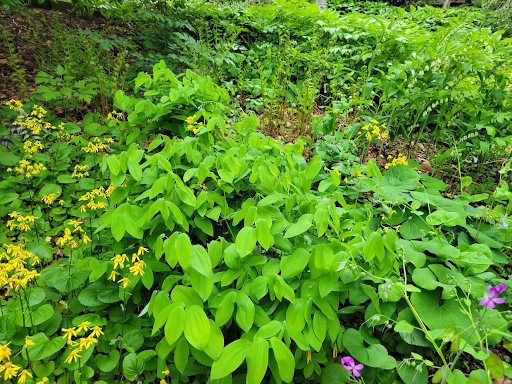
A dense planting of bloodroot (Sanguinaria canadensis) in a sunny location. Cristina said that these die back before her other bloodroot in a shady location, but these were much denser than the ones in shade. Also, notice the shooting stars (Dodecatheon Meadia) nestled between the bloodroot.

BELOW – Different species of Trilliums in one spot along with bluebells and bloodroot – Toadshade (Trillium Sessile), Sweet Little Betsy (Trillium Cuneatum) and one unidentified to the bottom right.
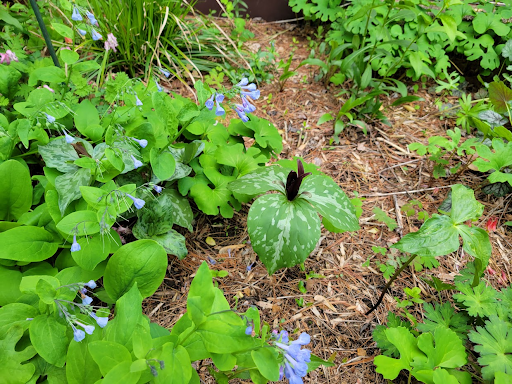
NEXT—This is Cristina’s favorite combination: Foamflower (Tiarella cordifolia) paired with Woodland Phlox (Phlox divaricata).
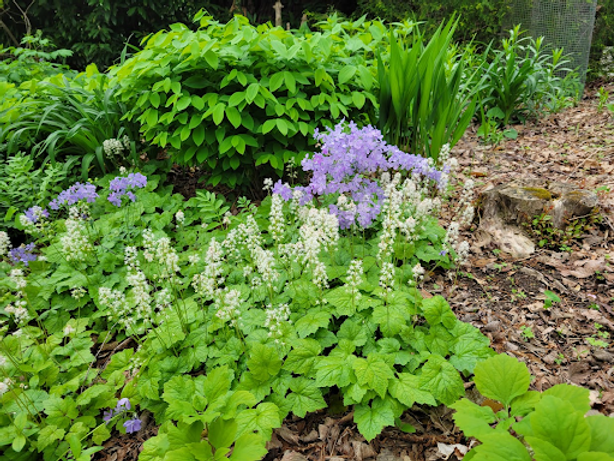
I’ll conclude with a few key take-aways:
- Don’t hesitate to experiment! Over the years Cristina obtained plants at swaps, bought them from sustainable propagators, and she planted them in different locations of her yard. She experimented with planting a patch of mayapples in one part of her yard, and they thrived. The other patch was not as happy, which was clear because of their smaller size.
- Spend some time planning your garden. Give some thought to where the walkways will be and the size of each bed. You should allow yourself easy access to every corner of your yard.
- Patience! It took 25+ years for Cristina to get to this point and she said that there is still a lot of work left to be done. Be kind to yourself, and know that you will get there if you stay diligent and patient throughout your gardening journey. It is a long journey after all!
- Invasives are common. Much like many of us, Cristina also has her share of non-native invasives. She has a pretty large patch of Lesser celandine. What matters more is that we do our due diligence in removing them, so the native plants have a chance to prosper and fulfill their role in the ecosystem.
- Work on reducing turf grass. A no-turf yard is just as green, probably more beautiful and definitely fosters biodiversity thereby serving to be a healthy ecosystem for our wildlife. And the best part: No mowing needed!
Happy Gardening! ❀
